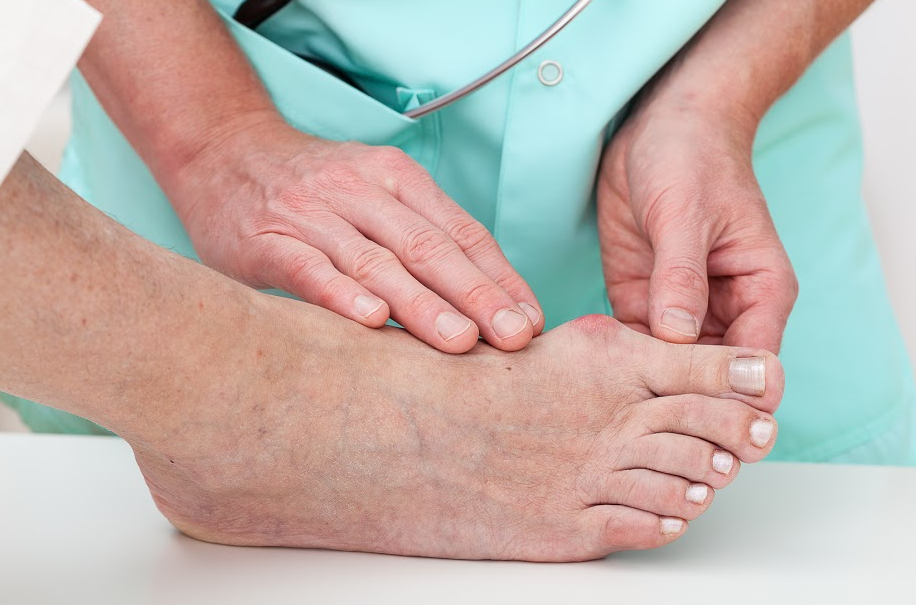or Call 770-284-1616
A bunion, also known as hallux abducto valgus, is a foot condition in which your big toe points toward your second toe instead of pointing straight ahead. This misalignment causes a bump to develop on the inside edge of your big toe and first metatarsal bone. This causes your big toe to point away from your foot. Not all Atlanta bunions are painful. Bunions are progressive and may be asymptomatic in the beginning, but as the misalignment in your big toe worsens, you may develop pain and other symptoms later.
Causes
Foot types are inherited and certain foot types cause people to develop bunions. Bunions occur more in women than in men. Shoes with narrow toe box can make bunions worse. The bump on your big toe may become reddened as a result of pressure from your shoe rubbing on your big toe bump or prominence. This will irritate the skin on the side and top of your bump and causes pain especially in people who wear footwear that does not accommodate the bunion deformity.
Other factors that may increase the chances of developing a bunion include:
- Long-term use of high-heeled shoes
- Arthritis
- Toe trauma
- Laxity of your connective tissues (ligament laxity)
- Limb length discrepancies (unequal limb length)
- Genetics
- Certain foot problems (e.g. flat feet, over-pronation, etc.)
Symptoms
Some of the symptoms associated with bunions include:
- Pain or soreness
- Redness at the side of the bunion
- Blistering at the bunion side
- Callus formation
- Bursitis
- Numbness
Bunions are worsened by standing for long periods of time, using narrow toe box and high heeled shoes.
Diagnosis
Bunions are easily seen from the bump that appears at the side of your big toe. To get a full evaluation of the bunion, the foot and ankle surgeon will take x-rays of your foot to further evaluate the bunion deformity,and the condition of the joint.
Treatment
Bunion deformity is progressive, though some progress rapidly than others. Early treatments are geared towards reducing the pain and slowing the progression of the bunion deformity, but the condition is not reversible. Bunions respond well to conservative therapy.
Some conservative treatment for bunions usually involves the following:
- Using shoes with wide tox box instead of narrow toe box shoes and high heeled shoes that worsen the condition.
- Using shoe pads provided by the foot and ankle surgeon to prevent pressure and pain at the bunion site.
- Custom orthotics may be helpful in supporting the joints in your foot that cause forefoot instability leading to the bunion deformity.
- Applying ice at the bunion site to reduce pain and inflammation
- Non steroidal anti-inflammatory medications can help reduce pain and inflammation
If conservative therapy fails to relieve the bunion symptoms, and your daily activities are hindered by your bunion pain, a bunion surgery may be necessary.
A bunionectomy is a surgical procedure performed on the soft tissue and bone involving the first ray in other to remove the bump and realign the big toe. In such a case, with the help of your ankle and foot surgeon, your foot x-rays will be evaluated and the doctor will discuss with you on the type of bunionectomy surgery that will most benefit you as an individual, while taking into consideration your symptoms, age, activity level, and other factors that will necessitate a quick recovery and relieve of your symptoms.
It should also be noted that after the surgery with tradition bunion surgery performed in the hospital, the patient may not be able to bear weight on the foot with the surgery and follow up appointments will be needed with more x-rays to confirm the position and healing at the surgical site.
However, ourMetro Atlanta Podiatrists use minimally invasive bunion surgery techniques. The advantages of using minimally invasive bunion surgery techniques include
- Appealing cosmetic results: Very small incisions with few to no stitches, so you can hardly see a scar
- No pins or screws are used
- Short procedure and short recovery time, quick return to normal activities
- Minimal post-op discomfort: Patients are able to walk immediately after surgery
- Local anesthesia is used, which is much safer than general anesthesia
- This is an in office procedure
We will be glad to take a look at your bunion and help you get back on your feet again.
